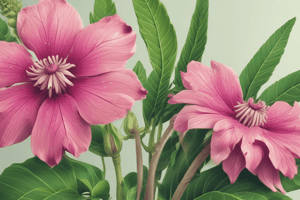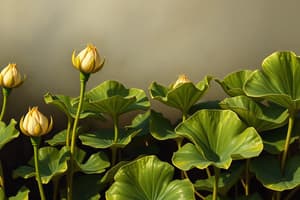Podcast
Questions and Answers
What is a characteristic feature of monocot roots?
What is a characteristic feature of monocot roots?
- Presence of a pith in the center (correct)
- Presence of a vascular cambium
- Undergoing secondary growth
- Absence of a pith in the center
What is true about herbaceous eudicot roots compared to monocot roots?
What is true about herbaceous eudicot roots compared to monocot roots?
- Their xylem and phloem form a solid mass. (correct)
- They undergo secondary growth.
- They lack a pith.
- They have more cambium than monocots.
Which statement accurately describes the vascular cambium in monocots?
Which statement accurately describes the vascular cambium in monocots?
- Monocots contain multiple cambium layers.
- Monocots always undergo secondary growth.
- Monocots lack a vascular cambium. (correct)
- Monocots have a vascular cambium that enables secondary growth.
Which of the following is NOT a characteristic of dicots?
Which of the following is NOT a characteristic of dicots?
What do dicots give rise to that monocots do not?
What do dicots give rise to that monocots do not?
What is the role of hairs on leaves in relation to air currents?
What is the role of hairs on leaves in relation to air currents?
What is one physiological change involved in leaf abscission?
What is one physiological change involved in leaf abscission?
Which of the following leaves is primarily used to produce the dye henna?
Which of the following leaves is primarily used to produce the dye henna?
Which economic importance of leaves is related to beverages?
Which economic importance of leaves is related to beverages?
Which plant is known for its flammable resin that can be used as fuel?
Which plant is known for its flammable resin that can be used as fuel?
What percentage of the earth is covered by saline water?
What percentage of the earth is covered by saline water?
What term describes plants that are adapted to salty habitats?
What term describes plants that are adapted to salty habitats?
Which of the following statements about halophytes is true?
Which of the following statements about halophytes is true?
How do plants typically respond to increased salts in their environment?
How do plants typically respond to increased salts in their environment?
What distinguishes halophytes from glycophytes?
What distinguishes halophytes from glycophytes?
What is the primary function of the root cap?
What is the primary function of the root cap?
How do root caps respond to gravitational forces?
How do root caps respond to gravitational forces?
What characteristic of root hairs enhances the absorptive capacity of roots?
What characteristic of root hairs enhances the absorptive capacity of roots?
What substance do root caps secrete to assist in moisture retention?
What substance do root caps secrete to assist in moisture retention?
Which of the following statements about root hairs is true?
Which of the following statements about root hairs is true?
Which of the following correctly describes the phototropic behavior of root caps?
Which of the following correctly describes the phototropic behavior of root caps?
What is the lifespan of root hairs?
What is the lifespan of root hairs?
In what way do root caps assist a plant's growth towards moisture?
In what way do root caps assist a plant's growth towards moisture?
What is the primary function of tendrils in plants?
What is the primary function of tendrils in plants?
Where are lenticels typically found?
Where are lenticels typically found?
What is the characteristic of a tuber?
What is the characteristic of a tuber?
Which of the following is NOT an economic importance of stems?
Which of the following is NOT an economic importance of stems?
What are suckers in relation to plant structures?
What are suckers in relation to plant structures?
What role do potatoes and sweet potatoes serve in a plant's structure?
What role do potatoes and sweet potatoes serve in a plant's structure?
Which of the following best describes a cladophyll?
Which of the following best describes a cladophyll?
What is the primary function of periderm associated with lenticels?
What is the primary function of periderm associated with lenticels?
What does the protoderm develop into in plants?
What does the protoderm develop into in plants?
Which type of meristem is primarily responsible for the increase in plant length?
Which type of meristem is primarily responsible for the increase in plant length?
Where is parenchyma tissue typically found in plants?
Where is parenchyma tissue typically found in plants?
What is one of the primary functions of the root system in plants?
What is one of the primary functions of the root system in plants?
Which of the following is not a type of plant organ listed?
Which of the following is not a type of plant organ listed?
Which nutrient is essential for plant growth and is commonly required in the highest quantity?
Which nutrient is essential for plant growth and is commonly required in the highest quantity?
Which system consists of the stem, leaf, flower, fruit, and buds?
Which system consists of the stem, leaf, flower, fruit, and buds?
How many types of plant meristems are specifically mentioned?
How many types of plant meristems are specifically mentioned?
Flashcards
Tendril
Tendril
A thread-like appendage of plants that helps them cling to supports like wires or bamboo.
Cladophyll
Cladophyll
A photosynthetic stem that looks like a leaf.
Stolon or runner
Stolon or runner
A stem that grows along the surface of the ground, producing new plants at its nodes.
Sucker
Sucker
Signup and view all the flashcards
Tiller
Tiller
Signup and view all the flashcards
Offset
Offset
Signup and view all the flashcards
Tuber
Tuber
Signup and view all the flashcards
Lenticel
Lenticel
Signup and view all the flashcards
Monocot root pith
Monocot root pith
Signup and view all the flashcards
Eudicot root xylem and phloem
Eudicot root xylem and phloem
Signup and view all the flashcards
Monocot vascular cambium
Monocot vascular cambium
Signup and view all the flashcards
Dicot secondary growth
Dicot secondary growth
Signup and view all the flashcards
Root cap function
Root cap function
Signup and view all the flashcards
Root cap composition
Root cap composition
Signup and view all the flashcards
Root cap tropisms
Root cap tropisms
Signup and view all the flashcards
Root hairs function
Root hairs function
Signup and view all the flashcards
Root hair lifespan
Root hair lifespan
Signup and view all the flashcards
Root hair structure
Root hair structure
Signup and view all the flashcards
Embryonic root (radicle)
Embryonic root (radicle)
Signup and view all the flashcards
Coco de Mer seed size
Coco de Mer seed size
Signup and view all the flashcards
Protoderm
Protoderm
Signup and view all the flashcards
Procambium
Procambium
Signup and view all the flashcards
Ground meristem
Ground meristem
Signup and view all the flashcards
Plant body
Plant body
Signup and view all the flashcards
Shoot system
Shoot system
Signup and view all the flashcards
Root system
Root system
Signup and view all the flashcards
Primary/Apical meristem
Primary/Apical meristem
Signup and view all the flashcards
Shoot apex
Shoot apex
Signup and view all the flashcards
Root apex
Root apex
Signup and view all the flashcards
Plant nutrients
Plant nutrients
Signup and view all the flashcards
Plant organs
Plant organs
Signup and view all the flashcards
Halophytes
Halophytes
Signup and view all the flashcards
Leaf Abscission
Leaf Abscission
Signup and view all the flashcards
Saline Environment
Saline Environment
Signup and view all the flashcards
Humidity and Leaf Structure
Humidity and Leaf Structure
Signup and view all the flashcards
Economic Importance of Leaves
Economic Importance of Leaves
Signup and view all the flashcards
Salt Tolerance
Salt Tolerance
Signup and view all the flashcards
Succulence
Succulence
Signup and view all the flashcards





